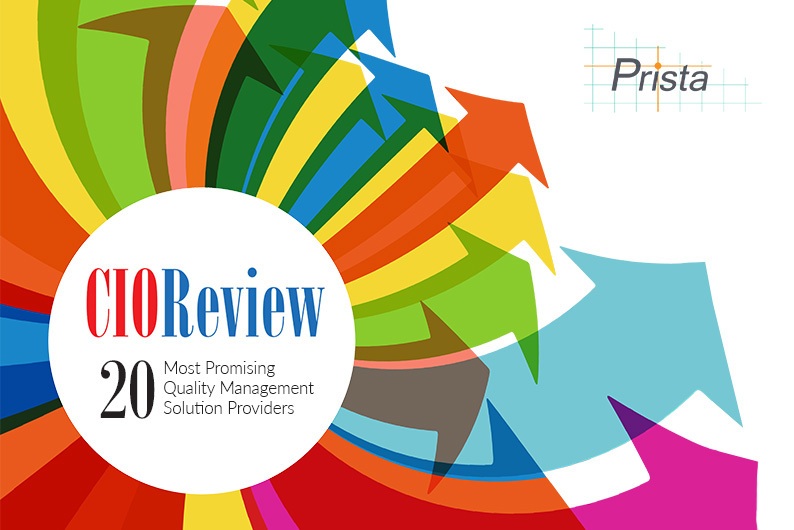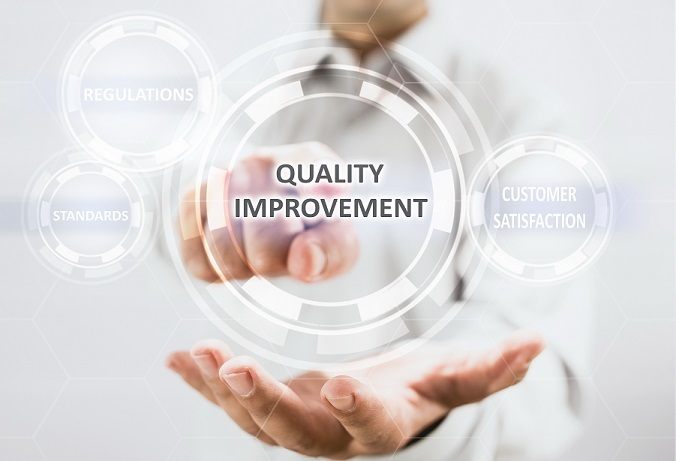Category Archives for Healthcare Innovation

Prista Named One of 2017’s Most Promising Quality Management Solution Providers
CIOReview recently recognized Prista Corporation as one of 2017’s “20 Most Promising Quality Management Solution Providers,” and we’re proud to have been recognized as a company that has demonstrated an exceptional ability to innovate and customize a solution that meets our clients’ quality management needs.
The December issue of CIOReview is centered around the idea that quality management is no longer a nice-to-have addition, but an aspect that is imperative for businesses to survive in the current competitive landscape. While this is certainly true, we believe when it comes to healthcare IT, a successful tool must enable quality management, safety event reporting and performance improvement teams to work collaboratively and efficiently, eliminating inconsistent, disorganized information, and facilitating effective improvement powered by real-time insights. Our mission to provide a tool that’s simple, collaborative and insightful was the driving force behind the development of the ActionCue CI application.
According to the magazine, ActionCue CI has changed the way hospitals manage risk, quality, and performance improvement by making information easy to access and understand. Our quality management clients appreciate ActionCue’s ability to provide insights, rather than numbers, through detailed reports that highlight the “big picture.” They can view reports and track data and trends in real-time, without ever touching a spreadsheet. With the ability to quickly investigate causes and manage corrective actions, our clients are able to take real steps toward improving patient care.
We’re delighted to have been recognized for our efforts in providing a solution that our clients truly value. If you’d like to learn more about ActionCue CI and why our innovation and commitment to increasing patient care quality is fostering a new “Culture of Quality” within the healthcare industry, check out some of our informational videos or read what our clients have to say about the tool.

Quality Improvement Performance Indicators: Prioritizing Your Data
In a recent blog post, the Center for Improvement in Healthcare Quality shed some light on an area of concern for many hospitals: the prioritization of data collection within their QAPI program. Hospitals are constantly working to monitor, report on and improve patient safety and quality of care, many of them collecting data on hundreds of performance indicators, but it’s impossible to monitor every single area.
This is where prioritization of data collection comes into play. The Centers for Medicare and Medicaid Services expects hospitals to prioritize high-risk, high-volume or problem-prone areas, but unfortunately, the agency is not specific on what areas qualify as such. However, the CIHQ suggests prioritizing performance indicators that are frequently cited for not being incorporated into a hospital’s QAPI program, such as:
Medication Use
- Sterile Compounding and IV Admixture
- Management of Hazardous Medications
- Medication Administration Practices for High-Risk Meds
Infection Prevention & Control
- Sterilization of Instruments & Supplies
- High-Level Disinfection of Instruments & Supplies
- MDRO and Isolation Practice
- Disinfection and Cleaning of Dialysis Machines & Equipment
Physical Environment
- Environmental Controls of Sensitive Areas (Temperature, Humidity, Air Balance)
- Maintenance and Operation of Critical Medical and Utilities Equipment
- Life Safety System Testing and Maintenance
- Implementation of Interim Life Safety Measures
- Protection Against Radiation Hazards
Food & Nutritional Services
- Food Service Preparation, Storage, and Cleanliness
Clinical Services
- Ordering Restraint & Seclusion
- Monitoring of Patients in Restraint & Seclusion
- Administration of Blood & Blood Products
- Protection of Patients at Risk of Self-Harm
- Administration of Sedation / Anesthesia
- Surgical and Invasive Procedures
While we support CMS and CIHQ in urging focus on certain performance indicators when a limited number can be tracked and addressed, hospitals should be very careful about reducing the number of tracked indicators due to time and resource constraints, because that could potentially have a damaging effect on the organization. The motivation to do so is often present and understandable, when hospitals are utilizing inefficient and labor-intensive performance tracking processes and tools. This is precisely the fundamental issue that Prista’s ActionCue CI application was designed to address.
ActionCue CI is your Fast Path to Insight™, monitoring all 19 performance indicators listed above and more, right out of the box. Its intuitive online dashboards provide critical QI/PI information to those who need it, when they need it. With gains in efficiency and productivity from using ActionCue CI, staff can carry out the quality, safety and improvement activities of the hospital, and cover and drive improvement on a larger number of measures, reducing the chances of being blindsided by a clinical performance issue or a derogatory survey finding.
In addition to comprehensive and efficient data collection, ActionCue helps hospitals take real actions to improve patient care, allowing staff to quickly investigate event causes and manage corrective actions through electronic event reporting. Many hospitals see significant increases in staff participation, communication and cooperation.
While it’s certainly important to take all necessary steps to avoid a CMS citation, ActionCue helps hospitals take quality and performance improvement a step further by truly creating a “Culture of Quality,” representing a collective and sustained commitment by organizational leaders to emphasize safety every single day.

Is Your Quality-Safety System Really a Do-it-Yourself Project? Should it be?
We frequently describe ActionCue Clinical Intelligence as redefining and facilitating the management process for quality-safety improvement. Understanding that taking on quality-safety improvement can bring some apprehension, we want to make clear that we do this to bring a radical increase in efficiency to the process of improving patient care delivery for clinical staff, managers and executives.
Whether a facility or system’s solutions for quality and safety management, tracking, and reporting consists of paper and Excel spreadsheets, internally developed systems, or commercial applications, most of those scenarios have something in common: They require clinical management to spend a good bit of time on manual work. This can include:
- Researching required performance measure definitions and their application within the facility
- Setting the structure of criteria, measures, reports, graphs and notifications within the system
- Entering, manipulating and checking data multiple times as it moves from safety tools and organizations to the quality management arena, and on to the places, tools, and people involved in performance improvement and management information systems
- Creating and executing the mechanisms for communication and collaborating with various staff to carry out multiple fractured workflow processes
- Producing forms, diagrams and other artifacts, the primary purpose of which is to demonstrate adherence to the chosen process and methodology
- Using additional tools, systems or steps to produce static reports in a variety of formats for management review meetings
- Revising and re-doing much of the above repeatedly in response to changing external reporting requirements, additional or revised inquiries, recurring meetings, staff turnover, etc.
It should be noted that in many cases, a good bit of that manual work could be done by administrative workers but is too interwoven in the clinical and quality-safety work to hand it off without major disruption in productivity. In other cases, it requires the clinical professionals to develop skills in information technology and data manipulation that should arguably not be required of them. Both of these instances seriously dilute the application of their best skills, education and professional abilities to improving quality-safety.
Unfortunately, many clinical managers and their senior management accept this kind of manual effort, and the resources it consumes, as the norm for working in quality, safety and improvement. Some believe it is the only way for solutions to work exactly as they want. Even by turning to multiple commercial software vendors, much of this same function building is required as the vendor happily customizes their product and charges significantly for it both upfront and on a continuous basis, while tying up hospital staff in planning and reviewing the customization. After-sale charges can even become the vendor’s primary business model. At Epic Systems’ User Group Meeting in September of 2016, CEO Judy Faulkner said she identifies Epic as a programming shop. The company spends just over 50 percent of operating expenses on research and development each year. With that perspective, how likely is it that such a vendor is going to make the application itself match the needs of its users, or reduce the work of installation, amount of training needed, or degree to which the vendor’s billable time is needed for ongoing administration and updates?
Costs that may be dispersed into the operating budget are often “hidden,” but really add up when considering the Total Cost of Ownership (TCO) for the solution. Almost all of this fits into the “administrative overhead” component of healthcare costs, which is understood by most in the C-suite of hospitals today to be increasing disproportionately.
Once this “build our own” mentality sets in, inertia takes hold. It is common for quality and safety solution acquisitions to focus on one of these “toolkits,” or basic products needing customization that lasts months after purchase. Over time, the organization feels as if it has invested so much into their status quo solution that they certainly don’t want to make a substantial change and start the process all over again. This is especially true when it could impact the many overt work processes in which they have also invested time, money and training.
Many managers initiating searches for quality and safety management solutions may not realize that a well-designed “turnkey” application—embodying not only effective technology but also expertly-crafted healthcare operational design—can be configured in days, not months, to fit their organizations and operations, and similarly be reconfigured to match their evolving needs. While turnkey applications such as ActionCue may be uncommon in healthcare IT, distancing the organization from the practice of costly extensive internal or vendor-teamed software development is something companies in almost all other verticals have done over the years. Although this requires some adjustment in perspective when reviewing products designed for a large healthcare marketplace, the very common mentality of “doing what you’ve always done” is something healthcare providers can simply no longer afford.

Healthcare Innovation, Leadership and Action—Part 4
In a recent webinar for our ActionCue clients, Prista’s panel of experts answered questions about healthcare innovation and the role of leadership in creating action that improves patient safety and quality.
We covered nine of these questions in previous posts—Part 1, Part 2 and Part 3. In this one, we will discuss the final three questions. Before we begin, let’s review who the panelists in this webinar were.
As President and Founder of Prista, Don Jarrell brings more than 30 years of technology experience in products management, application design, technology strategy and intellectual property management licensing. Don has provided the vision for Prista and for the ActionCue application.
Billie Anne Schoppman is a Registered Nurse and CPHQ (Certified Professional in Healthcare Quality) with more than 30 years of experience in the healthcare industry. As the Chief Mission Officer at Prista, she brings her passion to create the most efficient environment for improvement.
Dr. Jake Redden is a member of Prista’s Advisory Board with expertise in patient safety, healthcare quality, human factors, crew resource management, and safety culture, and is certified in healthcare quality and patient safety.
10. What is the biggest or most strategic impact when using the kinds of innovations we’re talking about that directly benefit user organizations?
Don Jarrell: We talk a lot about innovation in terms of daily impact because we’re trying to adjust behavioral interactions regarding the quality and safety efforts, but we’re actually improving the entire management process too.
When we can use technology to shape the workflow and keep it moving so that incident investigations don’t stall, data doesn’t get unreported and various reports don’t drive right into the performance improvement segment, we’re changing the process by which hospitals are managed.
It’s not about giving a motivational speech and turning up the heat on people to get results. It’s about actually changing the process and facilitating what management is expecting by their presence and their actual involvement in the workflows to some degree, not in a way that’s going to overburden them or keep them connected at arm’s length, but in a way that uses all of the leadership principles Dr. Redden talked about.
These things will change the way the organization is actually carrying out its management process, and that’s what we’re really after. We’re not asking anybody to act heroically based on being super revved up in their motivations. We’re simply enabling them to work a little harder and contribute a little more. That will naturally turn into a sense of satisfaction that really helps sustainability.
Dr. Jake Redden: What I always look for from a strategic impact is the production of improvement. We’ve got to measure the amount of work done towards making improvements, whether it’s the number of policies updated, daily process audits, kaizens, rapid process improvement events, standard working element or SOPs.
We’ve got to get our front line employees to first speak up for safety and then be involved in the production of improvements. That is where the real strategic impact is going to come from. We drive innovation with improvement productions in order to make our units in hospitals more efficient, safer and patient focused.
11. What can managers who want to address system issues do when they don’t feel executives are listening?
Don Jarrell: If the CEO is not responding to input that they’re getting from managers, senior managers should be able to ask “Why don’t you think this is important?” Or phrased more positively, “What could we do to convince you that this is important? What change to the mechanics or the presentation of information or the flow of information could make you feel more engaged and like this was a higher priority?”
I don’t think there’s any way you can force somebody, but you can certainly dialogue with them to start off, just asking them the very simple why or why not questions, in a non-accusatory way, so that you can actually find out what the barrier is and how it can be addressed.
Dr. Jake Redden: The joke I use with my provider partners is the same joke I use for my executive team—you’ve got to tell them something three times before they’ve heard it once, and you’ve got to tell them three more times so they will think it was their idea.
What I always recommend people do is to make things visual for executive teams. They have a limited amount of time, so you’ve got to get in there and make the bad side of the information as visible as possible. Put it up there three different ways and continue to put it up there every single month in a unique, innovative way. Eventually they’re going to say, “You know what? We should do something about that.”
Again, you’ve got to be consistent. You’ve got to stick to it. If they don’t buy it the first time, you’ve got to subtly continue to sell that through frequency. You’ve got to make it visual until they finally admit there’s an issue, and then they’ll get involved with helping make that improvement.
12. Where can I get answers to my questions about performance improvement or healthcare quality?
Dr. Jake Redden: There are a ton of resources out there. Both Billie and I are big fans of the National Association for Healthcare Quality (NAHQ). If you look up what it takes to become certified in healthcare quality, they have an excellent reading list that they keep up-to-date. For patient safety, there’s the National Patient Safety Foundation, in association with the IHI.
It’s really tough being a quality leader in healthcare because there’s no quality school you can go to. I’ve seen hospitals that have just brought in lead engineers or improvement leaders from manufacturing and automotive. They don’t quite adapt to the culture, and they don’t develop the interpersonal relationships or adjust to the uniqueness of provider partners and our nurse leaders.
Of course, you can’t just bring in a nurse or a floor tech and expect them to have that kind of systems thinking ability or the 10,000 foot view of how we drive improvement for the long term through culture changes, either. You’ve got to find individuals who think differently and continually reinvest in those folks through seminars and classes
Billie Anne Schoppman: Drexel University has an online MSN degree in safety and risk management in healthcare, which is a great opportunity for learning. I think they’re going in the right direction and it’s good to see. You can also check out CPHQ and the CPHRM. They’re kind of separated, and I’d love to see them combined. It’s all about integrating it all together.
We are delighted that you have joined us for this series as we reviewed 12 important questions about Healthcare Innovation, Leadership and Action. Reach out to us via email or on social media if you have questions, comments or input on additional questions you think should be addressed.

Healthcare Innovation, Leadership and Action—Part 3
In a recent webinar for our ActionCue clients, Prista’s panel of experts answered questions about healthcare innovation and the role of leadership in creating action that improves patient safety and quality.
We covered six of these questions in previous posts—Part 1 and Part 2—and in this one, we will discuss three more questions. Before we begin, let’s review who the panelists in this webinar were.
As President and Founder of Prista, Don Jarrell brings more than 30 years of technology experience in products management, application design, technology strategy and intellectual property management licensing. Don has provided the vision for Prista and for the ActionCue application.
Billie Anne Schoppman is a Registered Nurse and CPHQ (Certified Professional in Healthcare Quality) with more than 30 years of experience in the healthcare industry. As the Chief Mission Officer at Prista, she brings her passion to create the most efficient environment for improvement.
Dr. Jake Redden is a member of Prista’s Advisory Board with expertise in patient safety, healthcare quality, human factors, crew resource management, and safety culture, and is certified in healthcare quality and patient safety.
7. Why would innovation in the quality and safety improvement process help with other pressures and demands on healthcare executives, like finance, regulatory and operations issues?
Don Jarrell: I wouldn’t want to be a healthcare CEO these days. The pressure is enormous and it’s coming from every sort of angle, internally and externally. We respect that and want to address the areas of greatest concern for hospital executives, particularly CEOs.
Quality doesn’t occupy the same space as when it was simply delegated to a mid-level team member and not given much attention. Thanks to the pay-for-performance landscape—with macro NIPS, ACOs and everything else—you’re either going to get penalized for bad quality or safety issues, or you’re going to miss out on incremental income if your quality and safety, and performance track records don’t reflect the right things.
There’s a direct link between quality, safety and your financial considerations, as well as your regulatory issues, because when licensure is on the line, you want to live up to all of those standards. However, many C-level executives spend most of their time trying to actually run the operation and struggle to find time to address other crucial issues.
By taking good care of the quality, safety and improvement process, we are essentially taking some of the pain away from the C-levels so they can spend more of their time looking at those other areas. The quality and safety efficiencies we focus on also have a favorable impact on all of these other areas.
By getting an efficient, comprehensive look at their quality and safety situation, C-levels and the individuals who report directly to them can immediately link that to what their organization is doing. That makes the entire executive review process, given the sort of CEO’s mindset or perspective, much more efficient.
8. How can a software application really impact leadership and why is that effect more sustained than when it’s gained from leadership classes?
Dr. Jake Redden: Nothing replaces the foundational understanding of patients’ safety within the total leadership curriculum. That is the reason almost all hospital CEO jobs require an MHA or graduate degree. Most leadership courses are not going to take you much further than answering the “why” question or trying to help build a platform which leadership can act upon.
Leadership classes and seminars will not tell you what has to be done every day in your hospital. Building a culture of quality and leaning towards a higher liability organization of care delivery takes everyone working together, with real time insight and meaningful feedback on how their efforts are contributing to the improvement of patient care throughout the entire hospital.
One of the suggestions from the National Patient Safety Foundation last month was to insure that technology is safe and optimized for patient safety. This certainly applies to medical monitoring, decision support software and electronic medical records, but it also applies to the tools that senior leaders are using to monitor and improve the safety landscape for hospitals.
By now, almost all executives realize unintended consequences related to implementing any new technology happen almost every time. Implementing a new technology inadvertently changes the way people work and reduces new and unanticipated problems that we’ve got to deal with.
Our executives are quick to acknowledge this realization and deal with adjustments out on the floor with our patient flows. However, we are bad with making those adjustments to our own personal work processes that can result in maximizing the benefits of any new technology and what it’s supposed to provide us as a decision maker.
As executives, we have to dedicate time every week to review reports and patient safety indicators that are unique to our organizations. We have to let our frontline experts make the improvement, but we also have to be there to provide support.
More importantly, leadership needs to provide the accountability to insure that improvement efforts and innovation are occurring at every single opportunity, big or small. Every unsafe condition, outdated care process, or safety report that gets completed should have a senior leader devoting protected time to the right oversight of patient safety, and driving innovative change and solid improvements.
Don Jarrell: From an outside analyst view, people use the term culture of quality a lot, but in a presentation I did for ASHRM, I talked about what it really means to have an operative culture of quality. It’s not the slogans, the posters on the wall or the methodology that’s named. It’s really how people feel about the culture of quality.
To put it another way, it’s that voice we hope is inside everyone’s head on the clinical staff repeating over and over, “This is how we do our work.” If you really want to hook into that in a way that is sustained, it can’t be just a speech the CEO gives. The continuity of leadership and leader participation is important, but to really get it to continually present for the users and clinical staff, you need to make it a part of their daily work.
That’s why we focus on actually giving organizations a workbench and a working platform for their collaboration, reporting and investigation, so we can change their behaviors directly as they work toward the goal of quality and safety.
Actually addressing the work rather than the mind has been a strong teaching method of behavioral psychologists for a long time. They typically contend that you don’t change attitude to change thinking and actions, you change actions to change thinking and attitude. We come in with a very behaviorist approach to changing the working environment by changing the working platform.
9. What best supports the expectation that these innovations will make a positive impact on our organization’s quality and safety efforts?
Billie Anne Schoppman: It’s tough to find one thing, but mine is action. We need to take action now to make a positive impact on our organizations. There’s always change in healthcare. Now is the time. Innovation is the new strategy.
Everywhere you look, whether it’s online or with evidence-based data, the movement is toward innovation. Why? Because we are doing operations well. You want to be efficient? That’s great. You want to be predictable? That’s good. But we want growth. We want to meet the demands of the future. We want to prove our value to the community and to our customers. That’s innovation.
We have processes that have been in place for years. Let’s allow people in the organization to be creative, because if they are, they will take risks, which will lead to actions that drive change. That’s the one thing that can have the most positive impact on organizations right now. Take a risk, be an entrepreneur and take action.
Dr. Jake Redden: I always help organizations fix things more effectively the first time. When the frontline staff sees a level of consistent engagement from the executive team, it increases support from other frontline employees. We see the enthusiasm and overall improved safety culture grow.
Consistency is where we fail. We start out with a lot of enthusiasm in the C-suite, but by the third month, we’ve stopped having our regular, protected time check-in meetings, and we’re bypassing stuff. It ends up looking like a lot of lip service to those frontlines, so executives have to be available and present, and expect improvement.
Accountability is where their money comes from on those frontlines. They’ve got to not only trust, but verify as well. They’ve got to go out and make sure that we actually fixed the things that were reported last month in order to do that consistently, every single day, and every single opportunity, big or small.
We hope you will read our final installation in the series about Healthcare Innovation, Leadership and Action, coming soon. Reach out to us via email or on social media if you have questions or comments, and let us know what challenges you’re facing and how ActionCue CI can make a difference for your patients.
